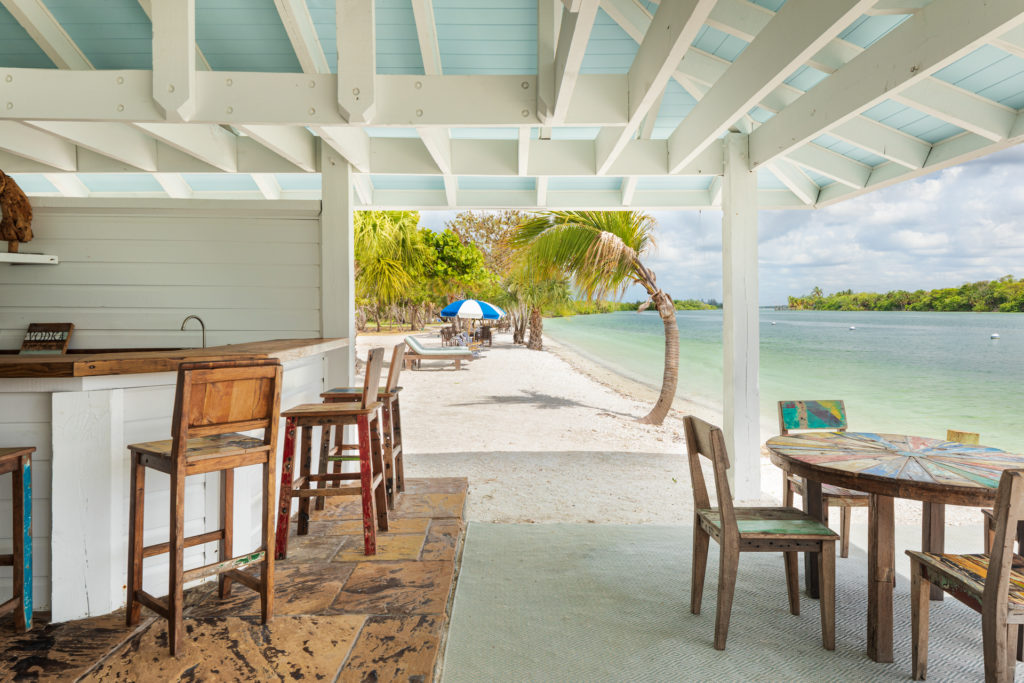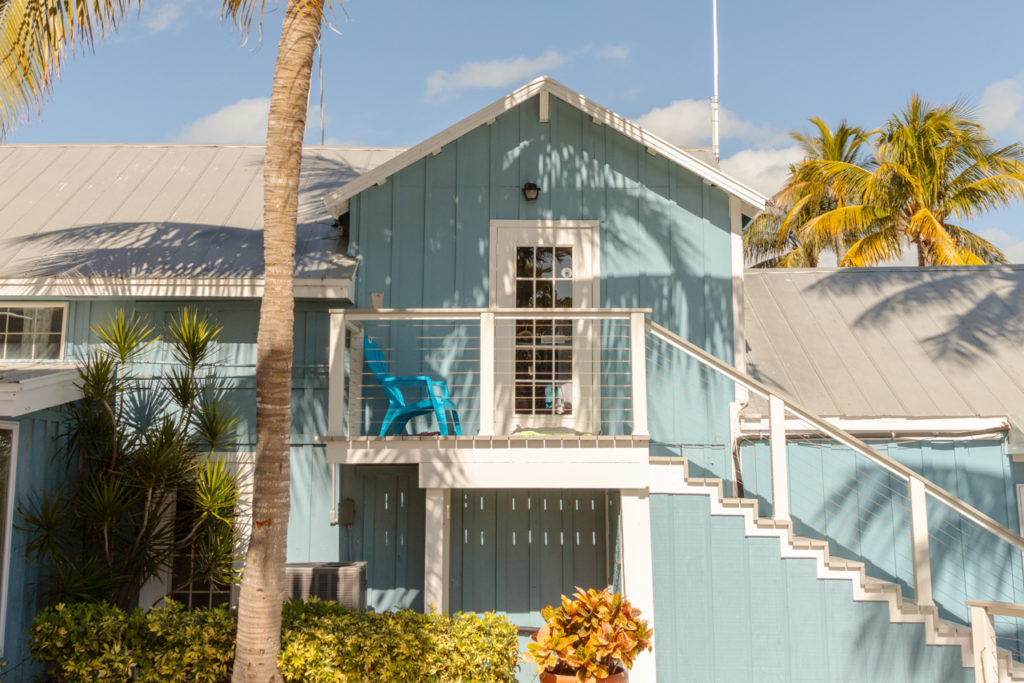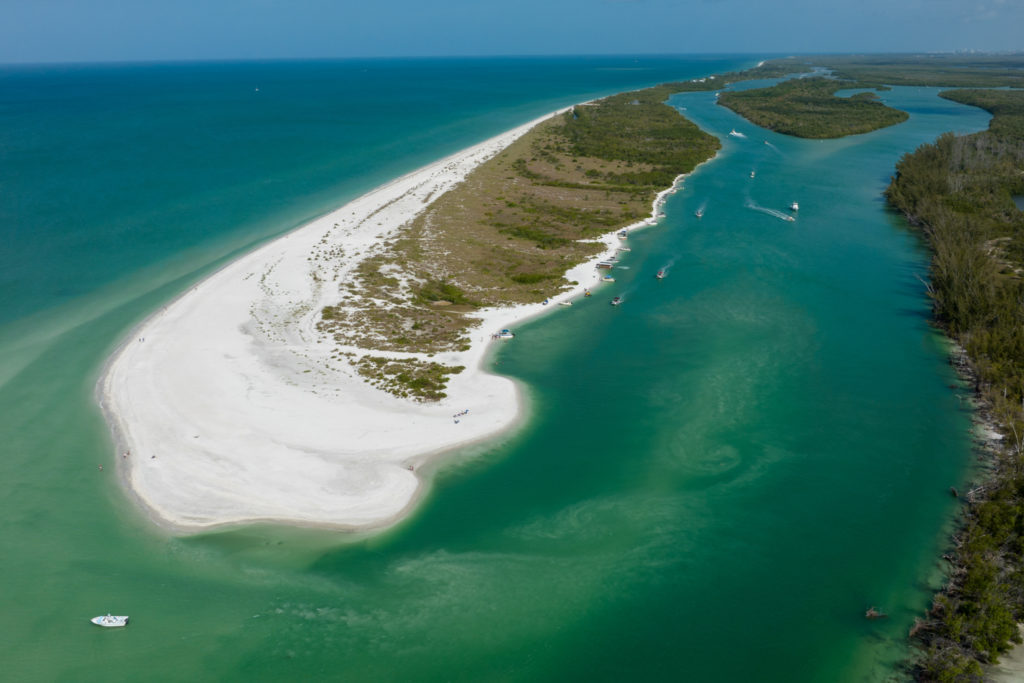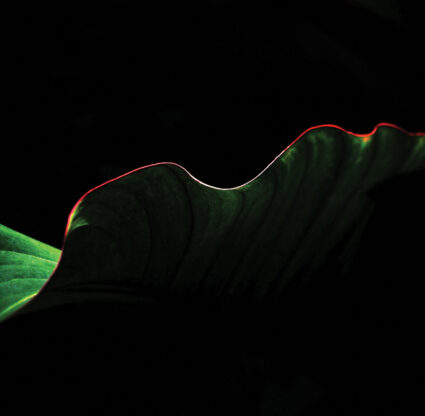Most people have to hop on a plane for an island getaway. In Southwest Florida, a network of barrier islands surrounds us, providing instant access to distinct experiences. Some are like private clubs with all the requisite remoteness and laidback luxury; others are built up and beckon those who want to get away from it all—while still having access to a great meal, art and shopping. Here, two writers report on the unique charms of our islands.
For Off-the-Grid Luxury: Keewaydin Island
After 12 years of living in Naples, I thought I had experienced all the up-close animal encounters I wanted to: dolphins frolicking in the wake of a yacht along a Port Royal canal; the hatching of a loggerhead nest steps away from The Ritz-Carlton, Naples; a goliath grouper hovering by the stilts of the Naples Pier; a tiny octopus that fit in the palm of my sister-in-law’s hand on Sanibel’s Bowman’s Beach; a manatee bobbing quietly in the backwaters behind the Naples Grande Beach Resort—even an alligator sneaking across a lake in our gated community.
The deer, however, I did not expect. On a retreat to a private residence on Keewaydin Island, a barrier strip that has zero cars and zero roads, my gaze lingered on a family of deer, the caramel-colored, spotted type I used to watch forage in my parents’ wooded backyard in northern New Jersey. They frolicked on the tennis courts before crossing the home’s helipad and onto a swath of bright white, untouched sand. I have never even seen deer in South Florida. But if there’s a place to experience unadulterated nature—albeit, in the most pampered yet unpretentious of circumstances—it’s on Keewaydin.
The barrier island’s real name is Key Island, but no one calls it that. It sits just below the tip of Port Royal on the inlet where Naples Bay empties into the Gulf of Mexico and stretches 8 miles to the northern end of Marco Island. For perspective, Sanibel, which most consider big, is 12 miles long.
More than 80% of Keewaydin’s 1,300 acres are government-owned and protected from the overdevelopment that’s taken place on nearby barrier islands like Marco Island and Fort Myers Beach. There are only 12 properties, with a few more lots available to be built on, all of which are only accessible by boat or helicopter. On any given night, there are probably no more than 100 people sleeping on the island.
Since only a fraction of the island is connected to the city’s electrical grid and water system, the homeowners in this mostly off-the-grid sanctuary have to be perfectly comfortable living off solar power and generators. Yet, they’ll also ferry in chefs from Fifth Avenue South restaurants for private dinners without batting an eyelash.
Until recently, I was oblivious to this side of Keewaydin. Sure, I’ve pulled up on a pontoon once to moor on the public Keewaydin Island Beach, which is as far south as one can go on the isle. I later heard someone refer to it as “spring break beach” and thought, “Bingo.” It’s where Boston whalers compete to see who can blast their speakers the loudest, and a duo of concession-stand food boats anchors daily. From there, it is nearly impossible to imagine the network of eco-friendly solar panels, water cisterns and generators that are the norm just a mile beyond the thumping beats.
The only way to experience the real Keewaydin is through personal connections or careful planning. Stays at select properties occasionally pop up as auction lots on the charity gala circuit, which is how I found myself ferried in a yacht from a boat landing at the southern end of Gordon Drive to an imposing 4,700-square-foot lodge once owned by John “Jack” Donahue of the venerated Federated Investors. The rustic wooden structure—with cathedral ceilings, a wraparound porch and a stone-pillar grand entryway—channeled the understated luxury I’ve experienced in posh mountain retreats in Lake Tahoe and Linville, North Carolina.
Chef Jesse Housman from Bistro 821 had come in from the mainland to prepare dinner for us five couples. For an evening, it felt like time had stopped and we were alone in the world.
If waiting for or taking part in a bidding war is not your cup of tea, there is one home that is available to rent on a year-round basis.

On the southern end of Keewaydin, there’s the ‘Biden Bungalow,’ as it’s known in local lore because the President’s brother owned it from 2013 to 2018, when he sold to renowned local architects Randall Stofft and John Cooney. Now named Off the Hook Hideaway, the 5-acre property, wedged between wetlands, straddles the width of the island—meaning no matter which way you meander, you’ll stumble onto a beach. The two families primarily use it for weekend getaways and entertaining, and they rent it out when they’re not there. Michael Lawler’s luxury realty firm manages the rentals and tailors arrangements based on clients’ needs, whether that’s setting up transport to and from the island or stocking the kitchen’s twin oversize Sub-Zero fridges.
The powerhouse architectural team, responsible for many Port Royal homes, spent around 18 months gutting every room. In the end, the sprawling compound of six cottages has a grand total of nine bedrooms (with 17 beds), eight bathrooms, an outdoor bar, a solar panel field and a chef’s kitchen complete with two dishwashers and a 60-inch Wolf range. Cooney’s children have told him he can never sell.
He and Stofft employ a caretaker who travels there daily to keep it resembling a five-star beach resort—one with thoughtful details like showers on each beach and a king-sized elevated platform bed in the owner’s stateroom with 360-degree views of the surrounding nature, where feral hogs and bobcats weave their way in and out of the mangroves, palms and sea oats.
At another charity auction this year, my friends and I won an overnight to Off the Hook Hideaway. The package includes a dinner catered by Crave Culinaire, music from Billboard Award-winning artist Ira Dean and transport to and from the complex’s boat dock on a Formula 500 SSC 53-foot yacht.
I, for one, can’t wait to revisit the deer—and be mesmerized once again by Keewaydin’s varied charms.
—Dorothea Hunter Sönne
For a Cultural Escape: Sanibel & Captiva
Even as rain clouds shroud the setting sun, the drive over the Sanibel Causeway gets my heart pumping faster. A pelican glides alongside our car as we make our way down the bridge slope. Just below, on a sliver of beach, a fisherman stands knee-deep in the Gulf, his Mercedes casually parked alongside the crashing shore.
Recently, my husband and I booked an overnight stay at the historic Captiva Island Inn to spend a couple days exploring Sanibel and Captiva. We stayed at the Harbour House, built in 1985 at the mouth of the Roosevelt Channel. Local architect David Bornhorst designed the hideaway, as well as many of the homes within South Seas Island Resort up the road and The Green Flash restaurant next door, named for the elusive meteorological phenomenon that occurs as the setting sun hits the water. To see the green mirage, you need pollution-free, clear skies with a straight view of the horizon, making the islands an ideal vantage point. Even then, the flash is quick, and conditions have to be just right. We’re hoping to get lucky on this trip. But, for now, we have two art-filled islands and our charming cottage to enjoy.
With a white staircase leading to a screened-in porch on the facade, a private poolscape and a mangrove-lined boardwalk to the boat dock, our three-story beach house is quintessentially Captiva. Sandra Stilwell Youngquist, who owns the inn, along with R.C. Otter’s Island Eats, Sunshine Seafood Café and Wine Bar, Keylime Bistro and other Captiva mainstays, makes it her mission to preserve the island’s quirky, coastal character. Nearly all her businesses, including the mollusk-themed S Car Go trolley created to cut down on parking issues and drunk driving, are painted in pastel shades and decorated with beachy motifs.

The islands were once one landmass until a major hurricane in 1921 created Blind Pass, separating the two. (Nearly a century later, Hurricane Charley isolated North Captiva.) Sanibel and Captiva have since grown into distinctive respites. Sanibel was poised to be the next Miami, with white skyscrapers and commercial resorts, before locals stepped in to curb development in the ’70s. Now, the town banks on its natural assets, like the white ibises that play in the estuary along the 4-mile Indigo Trail at J.N. “Ding” Darling National Wildlife Refuge and the mollusk touch-tanks at the recently expanded Bailey-Matthews National Shell Museum. Captiva, meanwhile, is known for its unabashed use of pastel paint and Old Florida architecture. The moment you hit Captiva Drive, bubblegum-pink mansions and lemon-colored cottages greet you with names like “Bouganveilla Circa 1910” and “Meant to Bee” engraved on quaint signs along the road.
Golf carts and bikes fill the bustling Andy Rosse Lane, where many of the island’s businesses are clustered. We take off on our cart from there, cruising until we find the Captiva Chapel By the Sea, where locals and visitors have worshipped and wed for more than a century. After a lifetime of living in Naples and visiting the islands, I’m still surprised to find something new on every visit. Next to the chapel, we come across the Historic Captiva Cemetery, where the marble gravestones, covered with flowers and shells, are engraved with dates from the 1800s to the present day.
The changes—and unchanging character—of Sanibel and Captiva over some of that time are evident at the nearby Captiva Memorial Library and Civic Center, where longtime Naples artist Paul Arsenault has a show of plein air scenes he’s painted over four decades. The canvases depict wooden buildings that no longer exist and many staples that remain, like the 43-year-old, bauble-filled The Bubble Room restaurant, which recently expanded to include a gift emporium across the street with rare antiques.

While Captiva seems to stand as a time capsule, Sanibel has been mindfully modernizing. Major renovations have taken place at institutions, like Cielo restaurant and the multigenerational Bailey’s General Store. New places, like the tropical modern taco spot 400 Rabbits, are infusing the town with a hip, youthful edge. Among the most significant transformations is the one taking place at BIG ARTS (formerly Barrier Island Group for the Arts), founded in 1979 by a group of island artists, including famed illustrator Ikki Matsumoto and his fiber artist wife, Polly. The art center—which unveiled its new two-story building in 2020—hired a young curator, added more gallery space, brought in new technologies for interactive displays, and now hosts a full slate of shows that promote diverse artists, experimental exhibits and community events. When we stopped in on a Saturday, the center was hosting an open house. A jazz band played on the terrace, and in the performance hall, a film flashed old photos of Robert “Bob” Rauschenberg, the Matsumotos and other local legends who established the island as an art hub.
Rauschenberg famously described Captiva as “the foundation of my life and my work; it is the source and reserve of my energies.” That same energy seems to feed the local art we see at co-ops like Sanibel’s Tower Gallery and Hirdie-Girdie Art Gallery, and Captiva’s 2 Islands Gallery. These barrier islands famously influenced Rauschenberg and Matsumoto in the ’70s and ’80s, and they continue to inspire with their explosion of color; the uninhibited roseate spoonbills, pelicans and other resident animals that aren’t afraid to fly alongside your car or perch next to you on the beach; and the animated characters that roam the shores. For me, it’s the sense of wonder I feel sitting at Andy Rosse Lane Park, finally watching the green flash on the horizon.
—Jaynie Bartley




